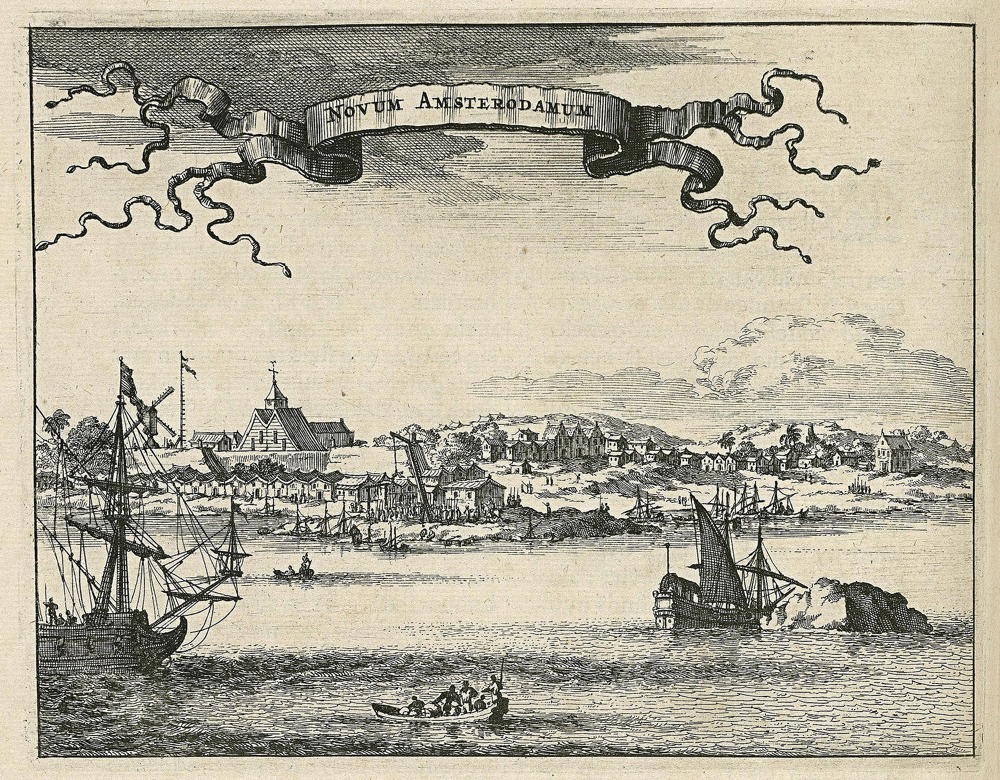NewAmsterdam

Jacob van Meurs: View of Nieuw Amsterdam.
Novum Amsterodamum (1662)
" … there were many mysteries involved in their history."
The Northern Netherlands began building their foreign trade early in the seventeenth century. They were late to the party. England, Spain, and even Portugal were well ahead of the Dutch in creating colonies. The Dutch weren't even a complete country yet, for they had split themselves in trying to separate from Spanish domination, the Southern portion of the country still Hapsburg Catholic clinging to Spain and the Northern part just exploring an identity as an independent nation. They were still trying to invent an identity when their Dutch West India Company began exploring territory in the New World: New Netherland. A contract English captain, Henry Hudson, investigating the possible existence of a shortcut to the Far East, "discovered" The Hudson River, resulting in a Dutch fur trading settlement in what would become Albany, New York. Manhattan, adjacent New Jersey, and Long Island were likewise claimed as New Amsterdam.
By 1636, The Dutch West India Company was importing contract laborers to colonize this territory, including my tenth great-grandfather Cornelis Aertsen Van Schaick. He labored for his contracted four years before returning to Old Amsterdam long enough to marry his sweetheart. He then returned to the New One, where he became prominent in the early development of Paulus Hook (current Jersey City, New Jersey) and, later, Manhattan. In February 1643, an "Indian uprising" destroyed his Paulus Hook property and buildings, killing several of his neighbors. He retreated to Manhattan, where he held leases on several properties, one bounded by present-day Wall Street, Maiden Lane, and the East and Hudson Rivers; another, from Peter Stuyvesant, included the present area of The Bowery. Indians continually harassed his properties until he relocated further north. His son would later develop his Bowery property, building the first church on the land that would later hold St. Mark's on the Bowery and a popular tavern.
Cornelis was a successful farmer, reputed to have provided many of the early colonists' fresh vegetables. He served on juries and committees and was a personal friend of Governor Peter Stuyvesant. In less than a generation, he'd risen from a common contract laborer to become a confidant of the governor, a nearly unimaginable advancement. The Dutch West India Company was one of the most brutal operations ever. It traded in salt, sugar, tobacco, fur, and Africans. The Dutch pretty much created the Atlantic slave trade, bringing Africans as laborers to their New Amsterdam colonies.
Further, at least twenty percent of the natives died of disease upon European arrival. No wonder the natives gave the Dutch and my ancestors little peace. It seems unlikely Cornelis didn't enslave people. Over the following three generations, the Van Schaicks would abandon Manhattan for Long Island, then leave Oyster Bay for Monmouth County, New Jersey, after my eighth great-grandfather Iden married his second wife, the daughter of prominent Scotch-Presbyterian, creating a schism in his Dutch Reform birth family. My Van Schaicks would relocate to New Jersey before the Revolutionary War. They were reputed to be fierce defenders of their property against Tories and refugees, organizing The Association of Monmouth County, referred to as The Hornets!
Shortly after The Revolutionary War, they headed West, first to Maryland by 1789, where my fourth great-grandfather Josiah was born, then across Kentucky, where my third great-grandfather Greenbury was born in 1826. Josiah was the first Van Schoiack to include an 'o' in the spelling. Names evolved. In 1852, Josiah left his homestead in Missouri to join an Oregon-bound wagon train. With him were his son Greenbury and Greenbury's son Ellsworth, my third and second-great grandfathers. Josiah lost a daughter and a daughter-in-law to cholera along the trail before succumbing himself along the brackish Platte that May. A surviving daughter returned two years later to exhume Josiah's body and rebury it in a formal cemetery in Missouri, for which Josiah had earlier donated land.
The rest of this family made it to Oregon and settled in Lane County, Cottage Grove, south of Eugene. My second great-grandfather, Ellsworth (Elza) Van Schaick, acquired that place in Eastern Oregon along Milk Canyon, where his daughter Clara would come to connect with my first great-grandfather, Nathaniel Parker Wallace, around 1885, marrying in 1893. I doubt they sensed the presence of New Amsterdam when they met. Thus, the Wallace Spoke, which stretches back to 1100, coupled with the Van Schaick one, which I hadn't earlier mentioned, stretches back into dim prehistory, nineteen generations to 1330. Clara and Nathaniel would bring my grandfather Elza into this world in 1896 in Condon, Oregon. He would meet and marry a Kenaston/Mayfield, my grandmother Ruby. I have yet to share the Mayfield story. It will be fuzzy, for many mysteries were involved in their history. I understand one of them, a great-granduncle or something, was shot to death in a disagreement involving a married woman. Another married into a family whose grandson became one of the more infamous gunfighters in the West. Stay tuned; we're not even halfway to my generation yet!
©2024 by David A. Schmaltz - all rights reserved


